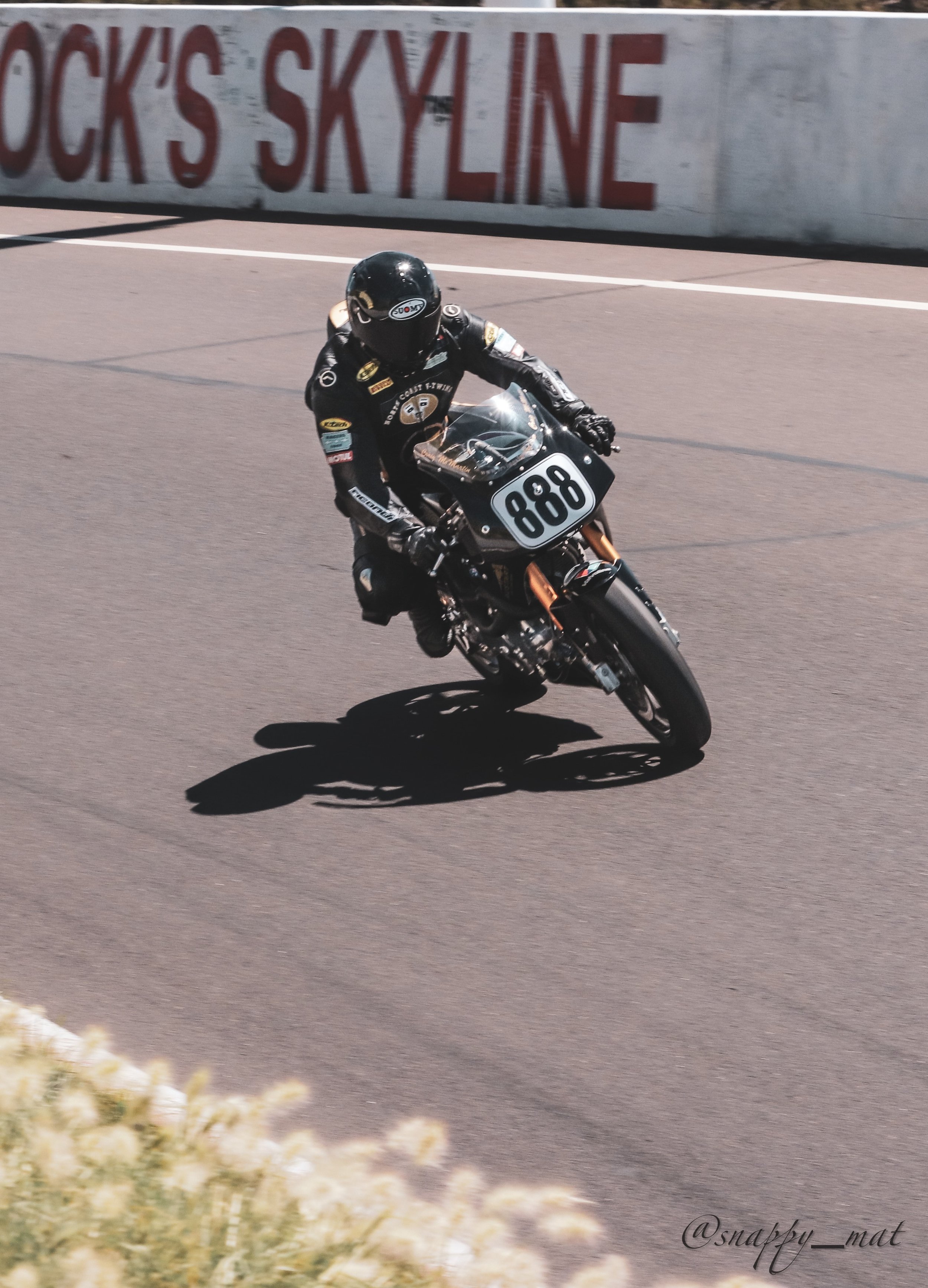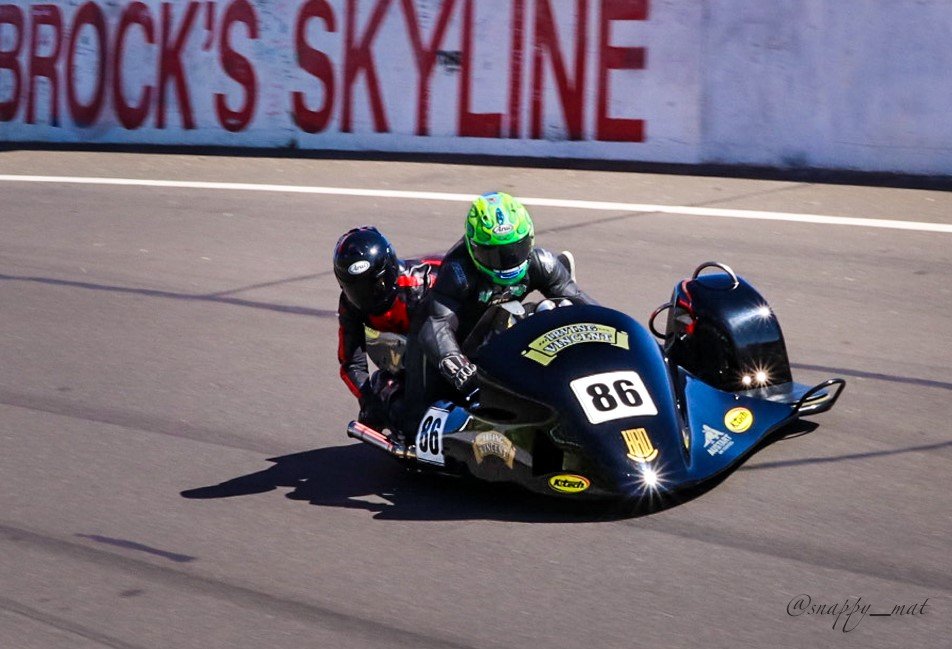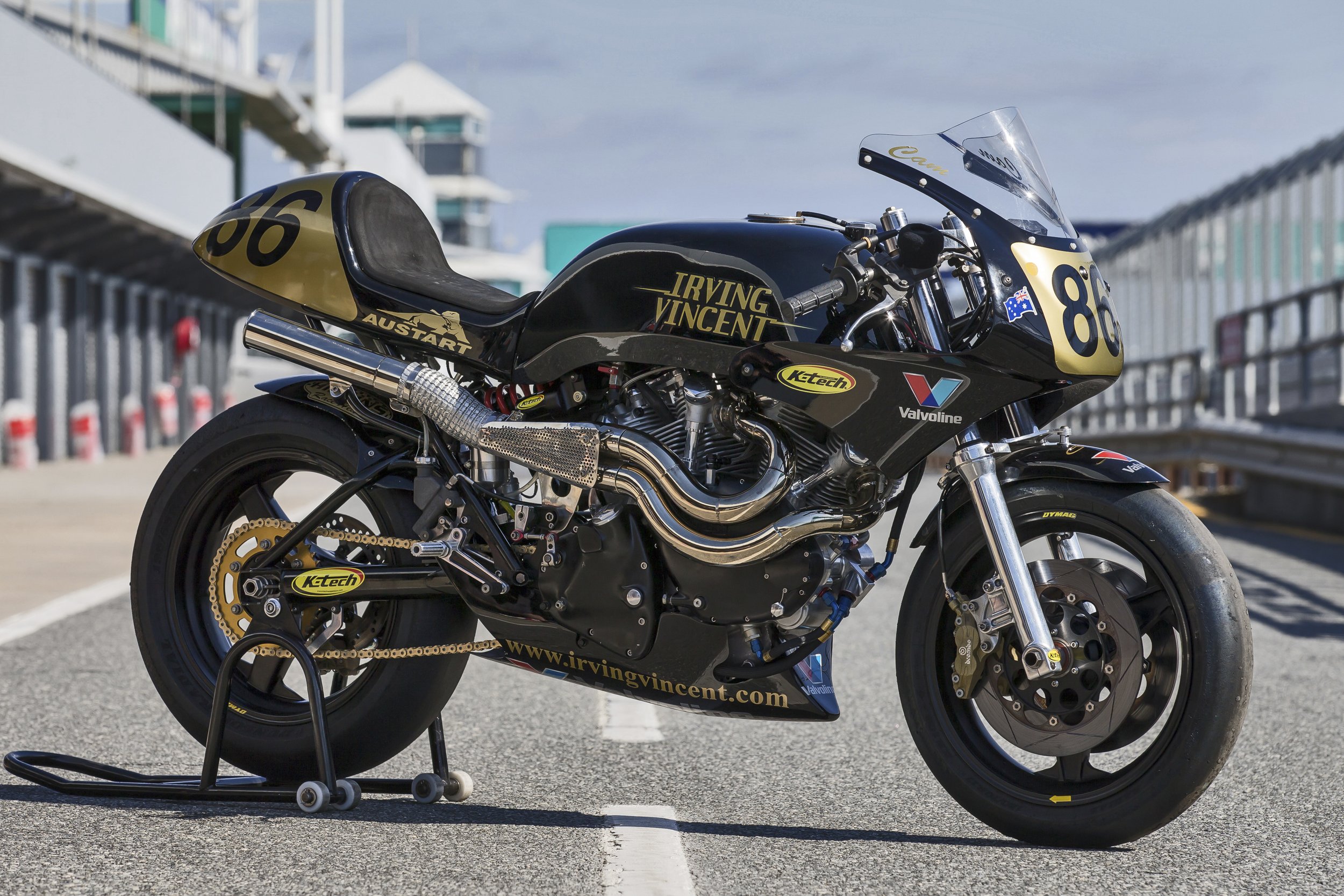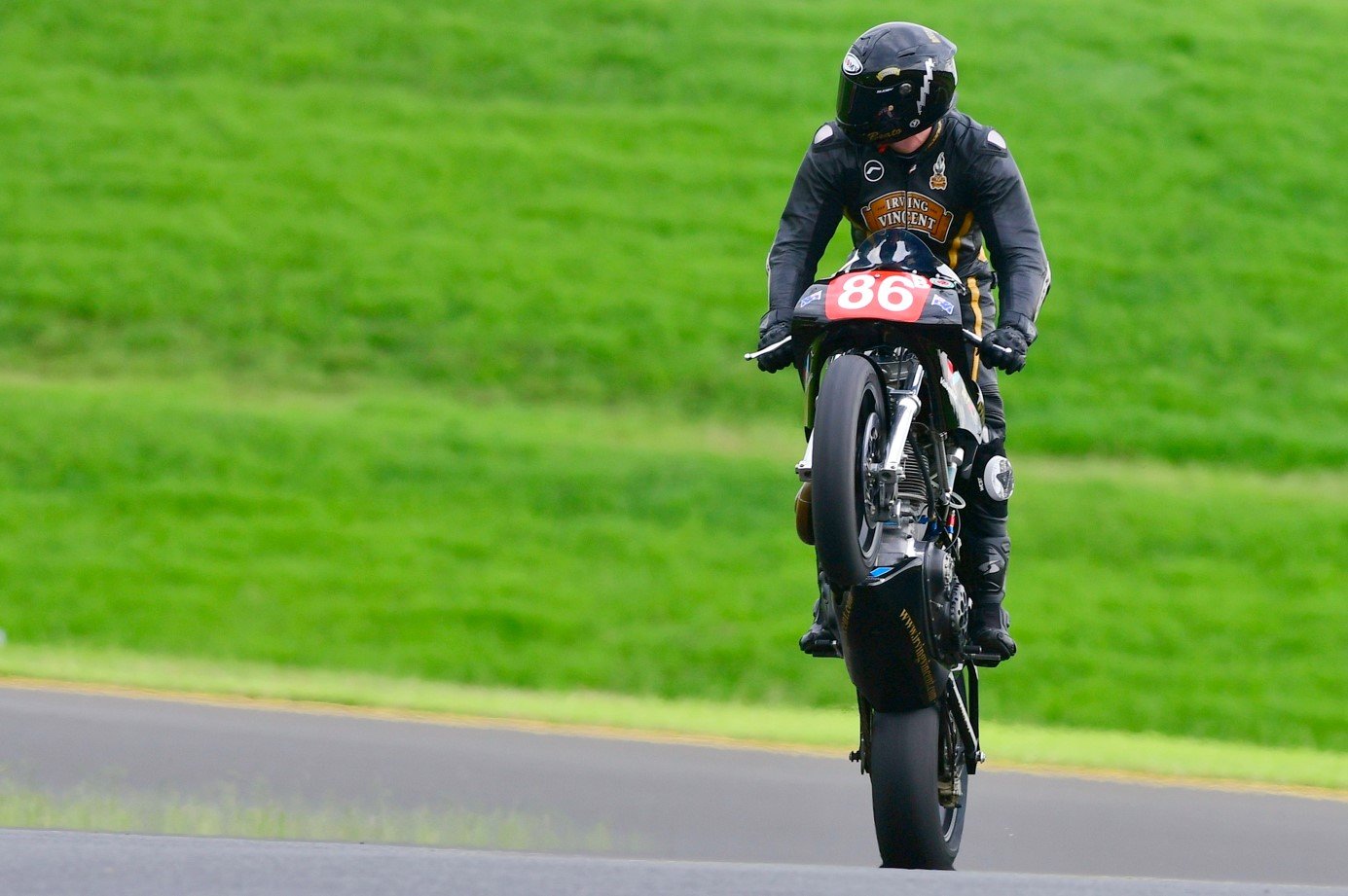VINCENT
By 1928, development engineer and passionate motorcyclist, Philip Vincent, had built a complete motorcycle and patented his unique ‘cantilever’ rear suspension design – a major component still used in almost every performance motorcycle frame today. In the same year, he purchased an existing motorcycle company, HRD Motors, for the princely sum of £450 and set about introducing his own brand of motorcycle to the British public under the Vincent HRD banner.
Originally reliant on external engine suppliers, after a disastrous 1934 Isle of Man TT campaign, along with Australian Phil Irving in his employ, the two set out to produce the world’s fastest production motorcycle.
Incredibly, only three months later, Irving had completed the design and development on his first prototype engine; an air-cooled, 499cc single-cylinder, pushrod, over-head-valve configuration named ‘Meteor’, which produced 26 Brake Horsepower, (19kW) @5300 rpm. As with almost everything this innovator developed, it was years ahead of its time – introducing unique features such as dual valve guides and a forked rocker positioned to eliminate side-pressure to dramatically reduce valve stem friction. A sports version named ‘Comet’ was capable of 90 miles per hour, (140km/h).
Within two years, (October 1936) Irving doubled the Comet’s capacity by morphing a duplicate cylinder into the design; creating the milestone of Vincent’s legendary air-cooled, 998cc, 47.5° V-twin engine. Designated the ‘Series-A Rapide’, with a compression ratio of 6.8:1, performance leaped to 45 brake horsepower (bhp), (34kW) @5500 rpm and a top speed of 110mph, (180km/h). Interestingly, in 1936, doubling the capacity produced 73% more bhp, equating to a 22% increase in speed.
A decade later, the never-ending thirst for performance was temporarily quenched when Vincent released the ‘Series-B Rapide’. With the engine as a “stressed member” of the frame and the oil tank forming the backbone of the structure, this state-of-the-art combination in design excellence vastly increased rigidity and handling over Vincent’s contemporaries.
Performance was further enhanced within three years, (1949) in a sports model aptly named the ‘Series-C Black Shadow’ due to its distinguishable black motor replacing the industry-standard polished alloy. While retaining the air-cooled 998cc configuration, the cylinder angel had increased to 50° with other enhancements including larger ports, bigger carburettors and higher compression ratio of 7.3:1. Power had increased to 54bhp, (40kW) and a top speed of 125mph, (201km/h).
Outperforming all other brands at that time, the ‘Black Shadow’ surpassed in power, speed, braking and handling. The Vincent brand had become the pinnacle of its era and their quest for producing the world’s fastest production motorcycle was realised – setting the standard for all others to follow. Inventing the side stand is another marvel of Vincent’s forward-thinking – and another technological achievement all modern motorcyclists can praise the ingenious Philip Vincent for.
The ‘Series-C’ models showcased the collaborative innovation of ‘Girdraulic’ forks. ‘Girder bottom-link’ and telescopic forks had already been invented; but “the two Phils” identified merits of the girder design over telescopic. However, they also realised the deficit in lacking any damping on compression or rebound – and inability to adjust trail.
Existing damper manufacturers remained dispassionate to their plight, so as with everything else, “the two Phils” re-directed their engineering talents and set about designing their own solution. ‘Girdraulic’ is an appropriate labelling of the perfected front-end assembly, but what lay beneath the name was amongst Irving’s most self-satisfying achievements – the ability to also adjust trail. The combined outcome of damping and trail adjustability vastly enhanced handling to compliment the all-impressive power plant. But, as with all racers, Vincent, Irving and their customers wanted more.
The Vincent racing models consisted of the 998cc V-twin ‘Black Lightning’, (weighing 38kg less than its road-going brother, the ’Black Shadow’) and the 499cc single cylinder ‘Grey Flash’.
Despite all the accolades and enviable achievements on-and-off race tracks throughout Europe, plus sales and land speed records in USA* augmenting the Vincent as the world leader in innovation and performance, the market either didn’t appreciate the brand’s unsurpassed quality and performance, or couldn’t afford them. Running a shiver throughout the global motorcycling industry, the magnitude of which remains among the darkest chapters in motorcycling history, refusing to diminish any aspect of quality for profit, Vincent Motorcycles entered into receivership in 1949. Sadly, the final Vincent rolled of the production line one week prior to Christmas 1955. It was appropriately labelled ‘The Last’.
*Questionably, the most famous of all motorcycling pictures is Rollie Free laying outstretched and perfectly horizontal aboard a Vincent Black Lightning, stomach on the rear wheel guard with all lower extremities trailing the rear axle, donned in only a pair of swimming shorts, helmet and slippers – while recording the 1948 USA national land speed record of 150.313mph (241.905kmh) at the Bonneville Salt Flats. Rollie made two passes in this fashion to claim the record – taking only 23.9 seconds to cover the measured mile.
In offering broad clarification toward model identification, models preceding Irving’s 1936 ‘Series-A Rapide’ were not designated by a “series”. These include the original 1934 – 35 Meteor, Comet and Comet Special, (also identified as the TT replica) supporting and aptly named after Irving’s iconic engines. ‘Series A’ models were “pre-war” – produced from 1936 to 1939, (war duties postponed production). ‘Series B’ 1946 – 1948, ‘Series C’ 1948 – 1954 and ‘Series D’ 1954 – 1955.
Having returned to Australia during 1949, in late 1963 Sir Jack Brabham and Repco engaged Irving to design a reliable, lightweight 3-litre, V8 engine to meet the 1966 Formula One specifications. Irving’s motorcycling heritage proved invaluable and the Australian pairing succeeded in winning the 1966 Formula One Driver’s Championship and Manufacturers’ Championship, (the only team owner/driver to do so; an achievement likely to be never challenged.) The following year Brahham finished second to teammate/ employee, Denny Hulme; earning the Repco Brabham team consecutive Formula One world championships.
Ever passionate about Vincent Motorcycles, Phil Irving held the honorary role as Vice-President of the Vincent HRD Owners Club from 1949 to 1979, only succeeding Philip Vincent as President after his passing. Irving retained the Presidency until his passing at age 88, in January 1992.
The radical brilliance of Irving and Vincent – and their passion for speed is rightfully marvelled at today – and by none more than two brothers in the outer suburbs of Melbourne, Australia. Ken and Barry Horner’s passion for excellence, speed and individuality, combined with a strong patriotic connection to Vincent Motorcycles, fuelled their desire to see how much further the performance of Irving’s legendary engine could be taken – so the Irving Vincent project was conceived – of which both namesakes would surely be proud.
Modern history
Ken Horner established his second commercial enterprise in 1987 – a general engineering company supplying hand-built machinery for a range of industries and appropriately named KH Equipment. Without knowing it, Ken’s innate aptitude for creativeness and looking beyond existing boundaries of possibilities, plus a strong belief in customer satisfaction, were to catalyse his change of fortune.
Good business develops from identifying a problem and offering a viable solution. The bigger the problem the larger the opportunity, and in Ken’s case, this initiated in the form of a little-known apparatus called an engine air starter. Operated by pneumatics rather than electrical current, (typically 24 or 12-volt) an air starter is a safety requirement for engines and vehicles operating in or around flammable environments such as paint or chemical warehouses. While more-readily available for several large-displacement diesel engines in exploration and mining ventures, at the time, finding an air starter to fit small capacity engines, such as forklifts, wasn’t easy.
When introduced to his customer’s dilemma in 1986, Ken initially adapted existing components to provide a suitable solution. However, once the scale of the problem was realised, it became a natural progression to design, manufacture and promote specifically-engineered units to accommodate this previously neglected market. Addressing this niche market was fulfilling and soon became KH Equipment’s primary function; under a new identity branded Austart – and at the cost of his sidecar racing endeavours with Barry. The international companies took five years to realise their shortfall and release similar offerings.
Prior to Ken’s involvement, all exploration, mining, oil & gas, maritime, heavy haulage and warehousing operations in Australasia had to import and modify existing components to suffice. However, with the availability of a locally produced product featuring unsurpassed quality and exceptional design advantages, the Austart range was well received and remains Australia’s only air starter.
Forever expanding the envelope of possibilities, around 1997 Ken further cemented Austart’s standing as the premium product by releasing a self-designed and manufactured turbine range.
Austart’s pledge of designing and producing the highest quality air starter to fit any motor – no matter its size – continues today with offices on every continent supporting global demand.
As with all success stories it wasn’t all plain sailing. One example in Ken’s case was sealing a distribution agreement throughout North America in August 2001 – until the repercussions of 9/11 crippled it soon thereafter. However, Austart’s reputation for quality, accompanied with superior design and customer service, has ensured global demand. Ongoing technological advancements will further enhance Austart’s prosperity.
Irving Vincent
Human behaviour predicts once an item becomes hard-to-obtain, the more in-demand it becomes – a Vincent bike, (or motor) being no exception. Exactly 13-years, (to the month) after the factory closed, intensive and consistent searching paid-off when Ken finally found a Vincent Rapide engine – although not accompanied with the original frame, but rather, as a partially-completed Vincent/ Norton project.
Word-of-mouth had led Ken to an American engineer, road racer and member of the Sandringham motorcycle club who needed a prompt return home, and therefore, a reluctant seller of a rare-but-fabulous ‘NorVin’.
To this day, regarded as the ultimate street-legal package of the 1950/60’s era, when Ken completed the project in 1970, his ambitions were reserved to brisk, pleasurable street-outings, however, as with many-a-champion preceding him, the realisation was the racetrack is the better part of valour – although a sidecar was the desired steed.
Having never run a racing lap, fittingly, Ken’s last ride aboard his ‘NorVin’ was at Phil Irving’s funeral in 1992. It remains registered - and amongst the never-to-be-sold items.
Truly infected by “the racing bug” with a passion for sidecars, a Vincent motor was always the preferred power plant, but the ‘NorVin’ wasn’t to be a victim of transformed desires, therefore, another extremely rare motor was sought.
Magically, in late 1970, a Vincent ‘Black Shadow’ motor appeared in ‘The Saturday Age’ newspaper. Instantly recognising the rare opportunity manifesting before him, Ken dropped previous plans and devoted all resources to make sure the motor advertised promptly became the centre of his road racing sidecar project. Rebuilding the Rapide for the ‘NorVin’ gave tremendous insight to the motor’s potential, starting with increasing capacity to 1300cc.
12 months of dedicated engineering saw the completion of the project with Ken set for the Unlimited Sidecar class, which lead to literally rubbing shoulders, (and fairings) with now Australian legends, the likes of Lindsay Urquhart, Alex Campbell, Ken Rumble and Dennis Skinner.
Continually amongst the frontrunners, with many individual wins, Ken’s dedication was also earnt him 3rd place at the 1974 Australian TT at Melbourne’s Calder Park. Further development and racing success, as stated earlier, was placed on-hold due to the expansion of his company’s Austart product range. Moving forward to the 1990’s...
Renowned Australian car racer and automotive magnate, Reg Hunt, (who finished second to Sir Jack Brabham in the 1955 Australian Grand Prix) approached Ken to rebuild a 988cc V-twin Vincent he’d bought from speedway sidecar legend Jack Walker for his ‘Bedstead’ project. Upon completion, flippant internal dialogue declared, “it would’ve been a dam-sight-easier to build a new one” fuelled the response, “so why don’t I?” With the Austart expansion under control, reasons weren’t forthcoming.
Once the proposition took a serious nature, obeying the brothers’ do-it-right-or-not-at-all approach, the first steps included a discussion with Phil Irving’s widow, Edith, to explain the passion inspiring their endeavour – that of applying new technology to establish modern outcomes of her legendary husband’s original design. It’s reasonable to assume Edith acknowledged similar intellect and enthusiasm that ignited the innovative design in the first place. Appraising her family’s legacy was in trustworthy hands, Edith wished Ken and Barry every success, but at the time, it’s unlikely that either party could comprehend the heights that wish would ascend.
By early 1999, the plan was to build a couple of “Classic” racing sidecars and solos under the Irving Vincent HRD, (Horner Racing Development) banner, but somewhere during the three year development and production of CAD drawings, patterns, jigs, tooling, castings and fixtures, the solo took precedence. Bike #1, built to contest the Period 4, Classic category, producing 130bhp, (97kW) was unveiled with Ken riding a few demo laps during the lunchbreak of the 2003 Philip Island Classic meeting.
A return to racing sidecars rekindled the fire in Barry, but racing a solo with vigour was to be assigned to someone of youth
and established credentials – the effort and performance figures warranted it. The trouble was, riders of the elk Ken and Barry considered worthy didn’t identify the results of their engineering brilliance, nor the local and international resurgence in Post Classic and Classic racing; considering the fully-sponsored ride beneath them, as they couldn’t comprehend a locally-reengineered, 67-year-old, pushrod design, being competitive against the might of the Japanese models only 20-25 years of age at the time.
Ken rode the next outing; the Geelong Speed Trial in the later months of 2003.
Proudly British, veteran motorcycle racer and internationally accomplished journalist, Alan Cathcart, naturally holds a strong and passionate knowledge of the Vincent period. Becoming enthralled in the Irving Vincent’s progression, he regularly enquired and in 2006 joyously accepted an invitation to ride and review the Period 4 bike. His article took on many forms, publishing in various magazines throughout Europe.
The Irving Vincent’s first international appearance had Barry and “sidecar swinger”, Chris De Nuzzo winning the 2006 ‘Sidecar Spectacular’ hosted at Pukekohe, New Zealand – producing two wins from two starts. Horsepower at the time matched the solo at 130bhp, (97kW).
A referral led to rising New South Wales, (NSW) young-gun Craig McMartin accepting a test session at Broadford, Victoria, in October 2006. Completing his first ride on the Period 4 machine, the question asked “what’daya think?” was met with the simplest of responses – “yep!” And history was in the making.
As with the Austart range preceding the Irving Vincent project, continued development remains a natural and on-going progression. Combined with Craig’s riding talents, the results began with four wins from four starts at the 2007 Island Classic; winning the Period 4 class and fourth overall in Period 5.
Three weeks later, at the ‘Barry Sheen Festival of Speed’ held at Eastern Creek, NSW, the team relished in a clean sweep of both Period 4 and 5 classes. The perfect scoreboard reads pole position and all wins in both classes – the two Phils, (Irving & Vincent) would surely be giggling in racer heaven.
Never to rest on one’s laurels and continuing with the original objective, that of pursuing the limits of Phil Irving’s 1936, 45 horsepower, air-cooled, “pushrod” design, the world-renowned ‘Daytona Speed Week’ in Florida, USA was chosen as the next objective. The stakes would be raised considerably due to having never raced there before, let alone on “banked” corners, plus they’d be competing against the very latest in modern V-twin technology – including multiple World Superbike Manufacturer’s Champion, Ducati and world-class riders, the likes of multiple World Superbike Champion, Doug Polen. On top of all this, the event program only allowed for 12 laps of practice. It was an insane prospect, but one the brothers Horner grasped with both hands, building a purpose-built 1600cc, 165bhp, (123 kW) machine. What an objective!
What an outcome! Race 1 – 3rd place. Race 2 – 1st place and outright winner of the AHRMA ‘Battle of the Twins’ – March 4th 2008.
Changing continents, The ‘Goodwood Festival of Speed’ is amongst the world’s most prestigious events. Participation is by invitation only and public ticket sales are capped at 150,000 per day – for the three-day event. Held in the private grounds of Goodwood house, West Sussex, England, owned by Lord March, regular participants include Formula One teams along with past and present world champion drivers and riders – the likes of John Surtees, Sterling Moss, Jackie Stewart, Lewis Hamilton, Sebastian Vettel, Kevin Schwantz, Kork Ballington, Valentino Rossi, Casey Stoner – and their magnificent machines.
World-wide acclaim following the Daytona victory surely caught the attention of the Goodwood organisers and an invitation to appear was graciously accepted in 2011 and 2012. Craig McMartin was accompanied by Beau Beaton for riding/show-off duties. (The event is classified as an untimed “Hill Climb” so wheelies and burnouts thrive.) Barry and Chris also entertained with the equally inspiring and immaculate sidecar.
The Goodwood estate encompasses an airport and race circuit, the latter of which hosts the annual ‘Goodwood Revival’. Gallantly accepting the esteemed invitation, Ken and Barry purchased and rebuilt an original Vincent ‘Series-C Rapide’ to deliver 96bhp, (71.5kW) (a phenomenal 113.3% increase in brake horsepower from the original 1936 design) and contest the ‘Barry Sheen Memorial Trophy’. During the event, seven-time World Motorcycle Champion and one-time Formula One World Champion, John Surtees CBE, commended Ken for his intricate advancements made to the ‘Girdraulic’ forks. (The moment is captured in 2015 Irving Vincent commemorative calendar offered for sale on this site.) John’s praise is valued not only due to his unmatched racing achievements, (still the only-ever 2 and 4 wheeled World Champion) but also for his personal knowledge of the Vincent motorcycle.
(John’s first professional race was with his father, aboard his Vincent sider. They won, only to be disqualified due to John being underage. Later, aged 16, John started his apprenticeship at the Vincent factory in 1950 and within a year was challenging world champion, Geoff Duke for race wins.)
As to be expected from an event and accolade of such magnitude, the prize is highly sought by rivals-of-calibre; such as British racing ace and Grand Prix winner, Jeremy McWilliams. Once again, the stakes were incredibly high.
Aggregate points from two races run over two days, under the guidelines of the era, comprising a Le Mans start and compulsory pit stop with rider change decided the results. Leading the charge for the European entrants, Jeremy was up for the titanic battle which unfolded, however, the Irving Vincent team emerged triumphant once again.
2015 saw a return to Australian domestic racing in the ‘Formula Xtreme, Pro-Twin / Naked Bike’ series. As with the Daytona races, this category is open to twin-cylinder bikes of any make, model and year of manufacture. The purpose-built, 1600cc, 4-valve per cylinder Irving Vincent won the 7-round national series with the air-cooled, pushrod motor producing 200bhp, (149kW). That’s an inconceivable 344.4% increase from Phil Irving’s original 1936, 45bhp design.
Being victorious on all three of the greatest motorcycle-racing continents – Australia, Northern America and Europe – the Irving Vincent team is undeniably amplifying the racing endeavours of Phil Irving and Philip Vincent. In doing so, they’ve enhanced the achievements and reputation of all those legendary Aussie racers, engineers and mechanics that paved the road before.






